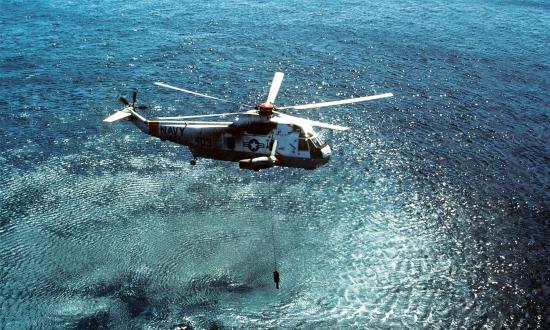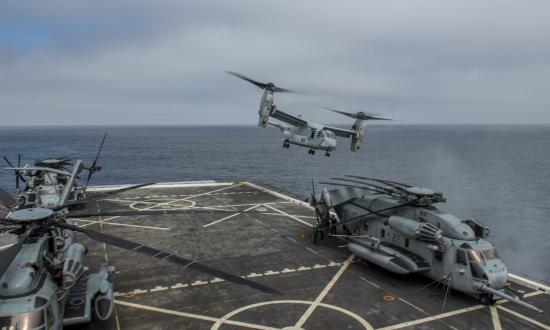The Navy focuses the bulk of its combat-systems development and creative thought on antiship cruise missile (ASCM) defense. Even the most capable multidomain warships, Aegis cruisers and destroyers, are designed for air defense. This singular focus inhibits creative thought and forces an air-defense mind-set into the underwater domain. With the demise of the Anti-Torpedo Torpedo (ATT) program, ships no longer have the hard-kill antitorpedo option. The Navy must compensate for the void in torpedo defense by developing antitorpedo mines (ATMs).
ATMs need some capabilities that the ATT did not have. The ATT defense system (ATTDS) consisted of the torpedo warning system (TWS) and the ATT itself. Both systems had functional issues: the TWS was unable to consistently detect inbound threat torpedoes and the ATT had difficulty consummating a hard-kill engagement against inbound torpedoes.1 Fundamentally, ATTDS mirrors the hard-kill concept of Aegis or the ship self-defense system—an inbound threat is detected, and a small weapon is dispatched to precisely intercept it.
The air and undersea problems are different and demand different approaches. Air is a volume and speed problem—a missile can come from the horizon or dive at a ship from a steep angle, it can maneuver in three dimensions or engage in a simple straight run, it can proceed at supersonic or even hypersonic speeds, and, using waypoints, it can attack a ship from any angle. To hard-kill an inbound missile, the ship must calculate where it is going to be and deploy a weapon to that precise location at a closure rate far greater than the speed of sound. ASCM defense is the equivalent of trying to hit a maneuvering bullet with another maneuvering bullet.
In contrast to ASCMs, torpedoes are relatively simple. Because of fuel limitations, most torpedoes are designed to close the target as quickly as possible. Wake-homing torpedoes use a ship’s wake for reliable guidance, but other guidance systems use straight shots at predicted points, acoustic or magnetic homing, or wire guidance. Non-wake guidance systems attempt to close the target directly. Therefore, on torpedo detection, an ATM-equipped ship would turn away from the threat and deploy several ATMs in its wake. Any inbound torpedoes, wake-homing or otherwise, would have to swim through the acoustic minefield and risk destruction. This is less a “hit a bullet with a bullet” problem and more like a baseball batting cage: the location and height of the ball is known, and the ship just has to hit it.
Required ATM Capabilities
ATMs provide a relatively simple answer to an inbound threat. Because the path of the threat torpedo is predictable, targeting is easy: the torpedo is going to be in the wake at a predictable depth. Like depth charges during World War II, it is a volume problem. During the world wars, destroyers would drive directly over a target and flood the area with high explosives at varying depths. Employing a similar, short-range, over-the-side weapon system means that the explosive load can be quite large and cover a significant portion of the torpedo’s potential path. To intercept an inbound torpedo, an ATM must meet the following criteria.
First, it must be able to quickly deploy into the ship’s wake to the threat torpedo’s search depth. A neutrally buoyant glider, deployed from the stern, would use the momentum of its deployment and its planes to rapidly sink, then level off at the desired weapon depth. This would allow the mine to wait in the path of the inbound torpedo until it could effectively engage.
Second, the mine must be able to detect the torpedo. This can be accomplished acoustically or magnetically. The mine’s sonar would detect high-bearing-rate contacts, indicating that
the target is quickly passing close aboard, and specific torpedo frequencies. As it passes the ATM, the torpedo will transition from a constant/low-bearing-rate to a high-bearing-rate target. Logics within the mine can detect this bearing-rate change and the magnetic field of the torpedo, triggering the ATM at the desired range.
Third, the mine needs to carry an explosive charge sufficient to provide coverage of a decent portion of the ship’s wake. However, the mine’s explosive radius need not cover the entire wake; in fact, employing multiple mines against a single torpedo would improve kill probability by providing multiple layers of ATMs.
Finally, tossing explosives into the wake poses a risk to own-ship systems. Therefore, ATMs need to account for the ship’s towed bodies. The mine could detonate against a threat torpedo in proximity to the AN/SLQ-25 Nixie towed acoustic decoy cables or the ship’s towed acoustic array. However, Nixie also is designed to detonate high explosives in the wake and its successful employment poses a similar risk to towed acoustic arrays. If employed in addition to Nixie, ATMs can be timed to prevent detonation until they have cleared sensor tow cables based on ship’s speed and array cant. In addition, detonator filters could be set to account for emissions from the Nixie system. However, destroying an inbound torpedo is always more important than towed-array preservation.
The surface navy has failed to adequately address the modern torpedo threat. Soft-kill measures such as Nixie, acoustic-decoy countermeasures, and evasion maneuvers are increasingly inadequate, and the fleet desperately needs a viable hard-kill option. Mines are cheap, simple, and deadly. Their lethality against threat torpedoes would meet the needs of the surface fleet and could save ships. This is a cost-effective solution to a pressing problem and warrants investment, modeling, and development.
1. Joseph Trevithick, “The Navy Is Ripping Out Underperforming Anti-Torpedo Torpedoes from Its Supercarriers,” The Warzone, 5 February 2019.







